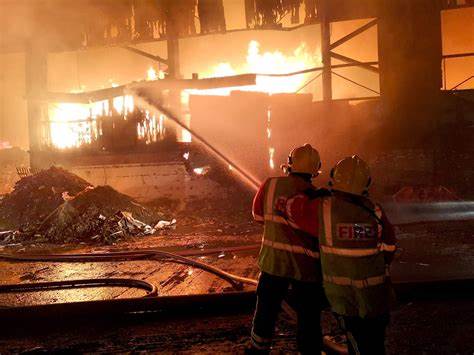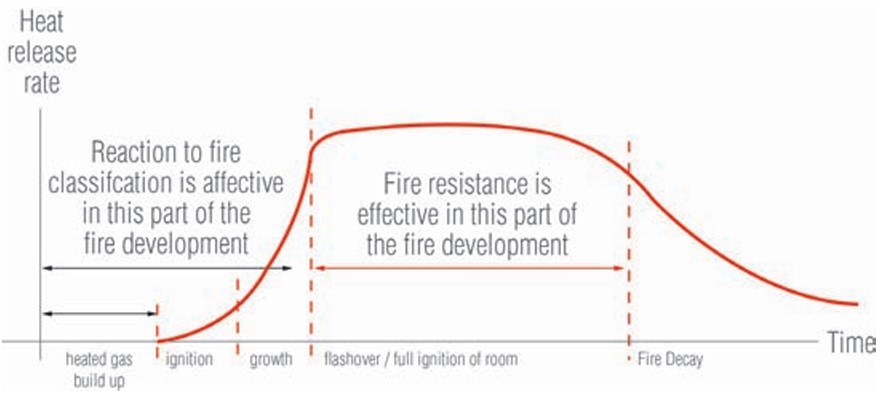This article offers guidance and recommendations on the design of timber buildings with respect to fire safety in modern timber buildings

Fire safety in modern timber buildings is of paramount importance due to the increasing use of timber as a sustainable and aesthetically pleasing construction material. Timber structures have become more prevalent in urban and residential landscapes, therefore the need to ensure their safety against fire hazards is of intense concerns. Effective fire safety measures in timber buildings not only protect the lives of occupants but also preserve the structural integrity of the buildings, preventing catastrophic losses and ensuring long-term resilience.
Timber, while offering numerous environmental and design benefits, poses unique challenges when it comes to fire safety. Its combustible nature necessitates the implementation of rigorous fire prevention and mitigation strategies. Therefore, understanding the behavior of timber under fire conditions and employing fire-resistant methods is important if architects, engineers, and builders must create structures using timber.
This article offers guidance and recommendations on the design of timber buildings with respect to fire safety in modern timber buildings
What is Fire?
Fire ignites through a dynamic interaction between oxygen, fuel, and heat, requiring all three elements to be present simultaneously. In most buildings, oxygen is abundantly available, making the availability of fuel a key factor in determining the initial growth of a fire. Figure 1 illustrates an idealized fire growth scenario, depicting the heat release rate over time for a fuel-controlled fire. This graph highlights two critical terms from building regulations: “Reaction to fire,” which classifies how materials respond to heat and fire, and “Fire resistance,” which measures a material’s ability to prevent fire from spreading between areas.

The heat release rate indicates the amount of heat produced by the fire, essential in understanding fire behavior. Real-world fire scenarios, especially in closed environments with doors and windows shut, deviate slightly from this ideal curve. The slope of the heat release curve in these situations is non-uniform due to intermittent fire development based on available oxygen levels. Initially, sufficient oxygen mixes with heated gases, promoting fire growth. However, in smaller rooms, oxygen can quickly deplete, causing the fire to decay. When additional oxygen is introduced—typically by opening a door or window—the fire can rapidly intensify.
This sudden increase in oxygen, known as ventilation, can accelerate fire growth dramatically, leading to a phenomenon called “flashover.” Flashover marks the transition to a fully developed compartment fire condition, where the fire’s intensity and spread pose significant risks to both structural integrity and occupant safety. Understanding these dynamics is crucial for designing effective fire safety measures in buildings.
Reducing Fire Ignition Potential
One of the primary responsibilities of designers and engineers is to minimize the potential for fire ignition. This involves careful material specification and detailing. Timber, while sustainable and versatile, is combustible. Therefore, integrating fire-resistant materials and coatings is essential. Using fire-resistant linings, such as plasterboard, can significantly enhance the fire resistance of timber frame panels. These linings act as a barrier, delaying the onset of fire and giving occupants more time to evacuate.
Limiting Fire Spread
The design of timber buildings must include measures to limit the spread of fire. Fire-resistant compartmentation is a key strategy. This involves subdividing buildings into smaller sections or compartments with fire-resistant walls and floors. These compartments restrict the spread of fire, confining it to its origin and preventing it from moving through the building.
Stopping Hot Gases and Smoke
Preventing the passage of hot gases and smoke is also crucial in maintaining a safe environment during a fire. Smoke inhalation is a leading cause of fatalities in fires, making smoke control systems indispensable. Incorporating smoke ventilation systems, alarms, and sprinklers can significantly reduce the risk of smoke-related injuries and fatalities.
Passive and Active Fire Protection
Fire safety in timber buildings is achieved through a combination of passive and active protection measures. Passive protection includes the use of fire-resistant materials and structural elements designed to withstand fire for a specified period. Active protection involves systems such as sprinklers, alarms, and smoke ventilation, which actively respond to the presence of fire.
The Eurocodes provide detailed guidance on passive fire protection, focusing on designing structures that maintain load-bearing capacity during a fire. This includes specifying materials and construction methods that enhance the fire resistance of the building. Structural engineers must consider these guidelines when designing timber structures to ensure they meet the required fire performance standards.
Compartmentation and Space Separation
Compartmentation and space separation are vital in preventing the spread of fire within and between buildings. In timber frame buildings, fire resistance is often achieved through fire-resistant linings on compartment floors and walls. These linings are tested to rigorous standards, ensuring they provide the necessary protection.
Cavity barriers are another essential component in timber buildings. These barriers are placed in concealed spaces to prevent fire from spreading through cavities. Proper installation of cavity barriers is critical to their effectiveness.
Reaction to Fire
The reaction to fire of materials used in timber buildings must be carefully considered. This involves assessing how easily a material ignites and how it contributes to fire growth. Timber products have known fire performance characteristics, and their reaction to fire is classified according to established standards.
The European harmonization of fire classifications includes assessments of smoke production and burning droplets. For instance, 9mm plywood and Glulam with specific densities and thicknesses can be classified without further testing, providing designers with reliable information on their fire performance.
Fire Resistance
Fire resistance is typically expressed in terms of time. It measures how long an element can withstand fire while maintaining its structural integrity, preventing fire penetration, and insulating against heat transfer. Building regulations specify the required fire resistance durations for different building elements based on their location and purpose.
Furnace tests are used to determine the fire resistance of structural assemblies. These tests simulate fire conditions to assess how long an assembly retains its stability, insulation, and integrity. The results of these tests are critical for ensuring that timber structures meet the required fire resistance standards.
Structural Fire Design
Designing timber elements for fire resistance involves several considerations. Engineers must account for the charring rate of timber, which varies with material density. Sacrificial timber, added to the design, allows for predictable charring rates and helps protect the structural integrity of the timber during a fire.
Calculations for fire resistance must be precise and consider the behavior of materials at elevated temperatures. The reduced cross-section method is used to determine the residual strength of timber elements exposed to fire. This method requires a deep understanding of the material properties and the consequences of failure.
Connections and Fasteners
Connections in timber buildings, often made with metal components, are particularly vulnerable to fire. Steel loses strength rapidly at elevated temperatures, compromising the integrity of connections. Therefore, protecting these connections is crucial.
Protected connections can be achieved by recessing fastener heads and covering them with fire-resistant materials. Internal steel plates require adequate thickness and edge protection to meet fire resistance standards. These measures ensure that connections maintain their strength during a fire, preventing structural failure.
Integrated Fire Safety Design
Fire safety design in timber buildings requires a holistic approach. It involves collaboration between architects, structural engineers, and fire safety specialists. Architects play a crucial role in planning fire compartment sizes and escape routes, ensuring that the building layout facilitates safe evacuation.
Structural engineers must be aware of the fire safety measures intended for the building and integrate these into their designs. This integrated approach ensures that all aspects of fire safety are considered, from material selection to structural detailing and active fire protection systems.
Compliance and Performance Declarations
Compliance with building regulations and standards is essential for ensuring fire safety in timber buildings. CE marking under the Construction Products Regulation mandates that fire safety is an integral part of product performance declarations. This provides assurance that materials and products used in timber buildings meet the necessary fire safety standards.
The required fire performance levels for structures are typically defined in terms of reaction to fire classification and fire resistance rating. These ratings provide a clear benchmark for designers and engineers, ensuring that timber buildings are safe and compliant with regulations.
Fire Safety in Practice
In practice, achieving fire safety in modern timber buildings involves a combination of design strategies, material selection, and testing. Designers must consider fire resistance from the initial design stage, as it affects various aspects of the building, including member sizes, construction types, and connections.
Fire-resistant linings, sacrificial timber, and protected connections are critical components of a fire-safe timber building. These elements work together to enhance the building’s ability to withstand fire and protect occupants.
Also See: Building Tall with Timber – Does it Make Sense?
Conclusion
Fire safety in modern timber buildings is a dynamic and complex field. The massive adoption of timber due to it been a sustainable construction material must also come with a recognition of the need for robust fire safety measures. Understanding the principles of fire dynamics, implementing effective compartmentation and space separation, and ensuring compliance with regulations, designers and engineers allows for creating timber buildings that are both beautiful and safe. Also, the integration of passive and active fire protection, along with precise structural fire design, ensures that these buildings can withstand fire and protect lives.